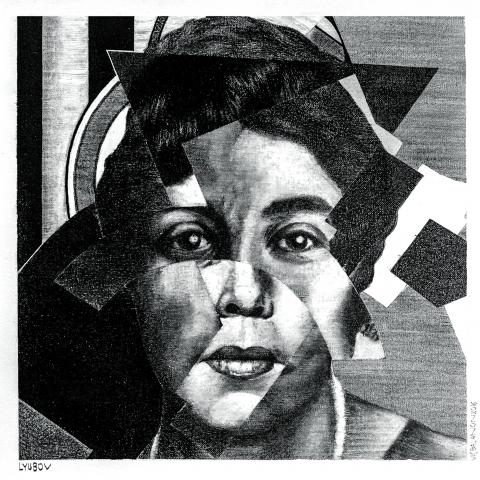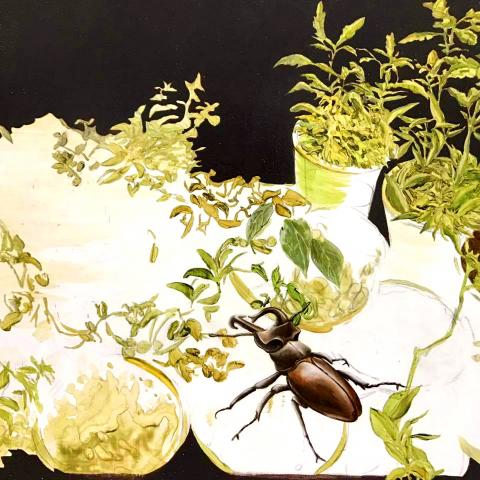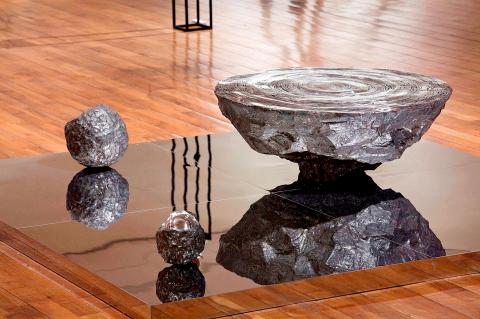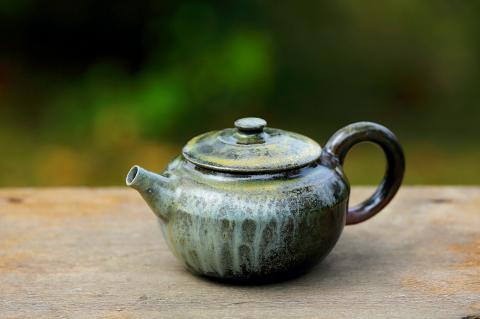Currently showing at Mind Set Art Center is For Tomorrow You Will Not Recognize Us (明日新貌), a solo exhibition by Filipino artist Victor Balanon who is known for his black-and-white paintings influenced by cubism. Here he paints a series of black-and-white portraits of famous avant-garde artists, though their faces are obfuscated by geometric lines and shapes, the result of which is both beautiful and grotesque. Like his other paintings, this series of portraits also has a multilayered and maze-like feel which has a dizzying effect.
■ Mind Set Art Center (安卓藝術), 7F, 180, Section 1, Heping East Road, Da’an District, Taipei (台北市大安區和平東路一段180號7F), tel: (02) 2365-6008. Open Tuesdays to Saturdays from 11am to 6pm
■ Until April 1

Photo courtesy of Mind Set Art Center
One, The One? (唯一.為一?) is a joint exhibition at ArtDoor Gallery featuring the works of six art students from National Taiwan Normal University that touch on the concept of spirituality, especially the idea that there is an intricate and tangible link between heaven and earth. It includes Chuang Teng-shiang’s (莊騰翔) spherical sculptures made from stainless steel and Tu Chih-wei’s (涂智惟) Chinese landscape paintings depict morbid and farcical people behaving gluttonously.
■ ArtDoor Gallery (藝境畫廊) 3F, 36, Lane 164, Hulin St, Taipei City (台北市虎林街164巷36號3樓), tel: (02) 2658-5268. Open Tuesdays to Sundays from 11am to 7pm
■ Until April 2

Photo courtesy of Yiri Arts
Wu Shu-ling (吳淑玲) conjures up the serenity of her native Miaoli’s alpine forests in her wood-fired ceramics, which will be on display at Caves Art Center starting tomorrow. The Quest for Light (貢旭煉影) will provide viewers with a rare glimpse of Wu’s teapots, vases and plates, all of which are made by traditional wood-firing techniques that date back to the Shang Dynasty. Wood firing techniques recently became popular again and Wu manages to achieve this in a way that gives her ceramics the appearance and feel of being modern and minimalistic but also of being unearthed from an archaeological dig.
■ Caves Art Center (敦煌藝術中心), 91, Fujin St, Taipei City (台北市富錦街91號), tel: (02) 2718-2091. Open daily from 11am to 7pm
■ Opens tomorrow. Until April 8

Photo courtesy of TFAM
Lin Yi-pei’s (林宜姵) paintings of insects and other critters crawling over plants and people’s bodies will have even viewers with the most extreme entomophobia captivated. The Final Mild Blue (最後一頁麥德布魯), held at Yiri Arts, explores the ways in which things we normally associate with being disgusting can also be viewed as intriguing or even beautiful. People, plants and insects seamlessly merge into one amorphous entity in Lin’s paintings which have both a calming and an alarming effect. Ultimately, her message seems to be that we shouldn’t be too afraid to unleash the demons inside us.
■ Yiri Arts (伊日藝術), 4F/1, 5, Ln 768, Bade Rd Sec 4, Taipei City (台北市八德路四段768巷5號4樓之1), tel: (02) 2786-3866. Open Tuesdays to Sundays from 1pm to 7pm
■ Until April 16

Photo courtesy of ArtDoor Gallery
Opening tomorrow at the Taipei Fine Arts Museum is Wielding Poetry (焊藝詩情), a retrospective on sculpture Kao Tsan-hsing (高燦興). Kao, who has been working with stainless steel, marble, glass, plaster and iron since the 1970s, has also been involved with public art projects and he occasionally dabbles in other media. For his most recent series, Kao used discarded steel plates that he collected from automobile factories and welded them together to form transcended-like 3D figures. The idea, he says, is to transform gritty, tangible objects into things that we associate as being other-worldly.
■ Taipei Fine Arts Museum (TFAM, 台北市立美術館), 181, Zhongshan N Rd Sec 3, Taipei (台北市中山北路三段181號), tel: (02) 2595-7656. Open Tuesdays to Sundays from 9:30am to 5:30pm and until 8:30pm on Saturdays
■ Opens tomorrow. Until June 25

Photo courtesy of Caves Art Center

Wooden houses wedged between concrete, crumbling brick facades with roofs gaping to the sky, and tiled art deco buildings down narrow alleyways: Taichung Central District’s (中區) aging architecture reveals both the allure and reality of the old downtown. From Indigenous settlement to capital under Qing Dynasty rule through to Japanese colonization, Taichung’s Central District holds a long and layered history. The bygone beauty of its streets once earned it the nickname “Little Kyoto.” Since the late eighties, however, the shifting of economic and government centers westward signaled a gradual decline in the area’s evolving fortunes. With the regeneration of the once

Even by the standards of Ukraine’s International Legion, which comprises volunteers from over 55 countries, Han has an unusual backstory. Born in Taichung, he grew up in Costa Rica — then one of Taiwan’s diplomatic allies — where a relative worked for the embassy. After attending an American international high school in San Jose, Costa Rica’s capital, Han — who prefers to use only his given name for OPSEC (operations security) reasons — moved to the US in his teens. He attended Penn State University before returning to Taiwan to work in the semiconductor industry in Kaohsiung, where he

In February of this year the Taipei Times reported on the visit of Lienchiang County Commissioner Wang Chung-ming (王忠銘) of the Chinese Nationalist Party (KMT) and a delegation to a lantern festival in Fuzhou’s Mawei District in Fujian Province. “Today, Mawei and Matsu jointly marked the lantern festival,” Wang was quoted as saying, adding that both sides “being of one people,” is a cause for joy. Wang was passing around a common claim of officials of the People’s Republic of China (PRC) and the PRC’s allies and supporters in Taiwan — KMT and the Taiwan People’s Party — and elsewhere: Taiwan and

Perched on Thailand’s border with Myanmar, Arunothai is a dusty crossroads town, a nowheresville that could be the setting of some Southeast Asian spaghetti Western. Its main street is the final, dead-end section of the two-lane highway from Chiang Mai, Thailand’s second largest city 120kms south, and the heart of the kingdom’s mountainous north. At the town boundary, a Chinese-style arch capped with dragons also bears Thai script declaring fealty to Bangkok’s royal family: “Long live the King!” Further on, Chinese lanterns line the main street, and on the hillsides, courtyard homes sit among warrens of narrow, winding alleyways and